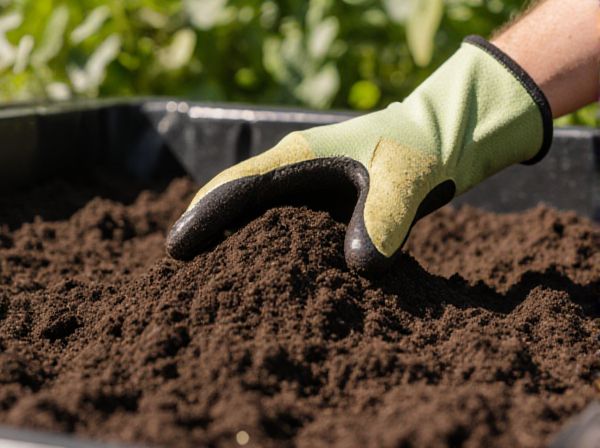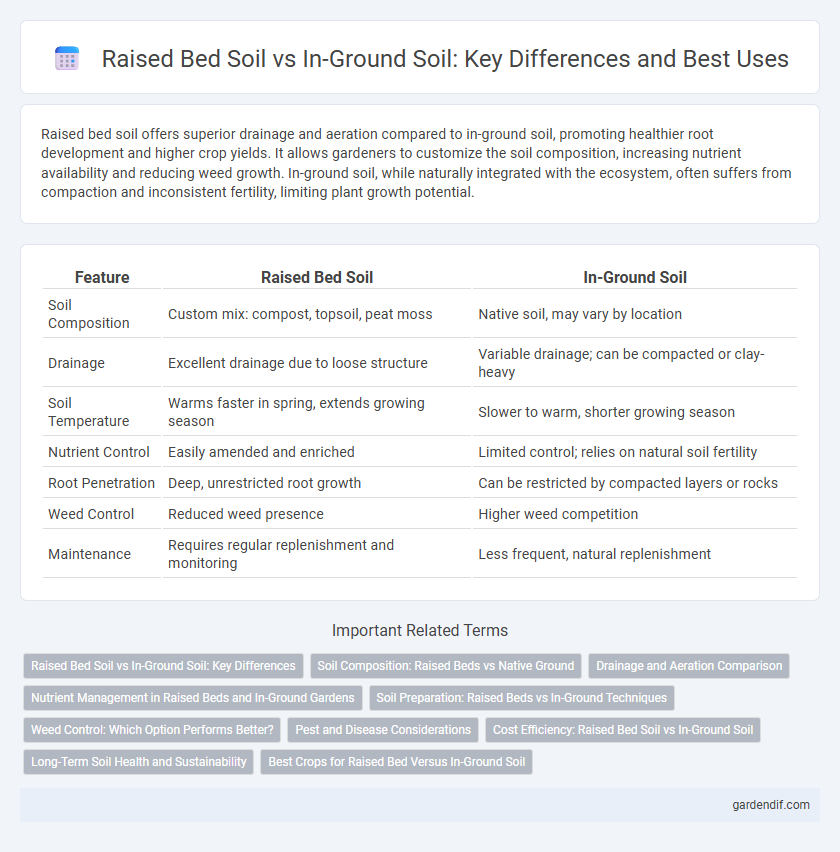
Raised bed soil vs In-ground soil Illustration
Raised bed soil offers superior drainage and aeration compared to in-ground soil, promoting healthier root development and higher crop yields. It allows gardeners to customize the soil composition, increasing nutrient availability and reducing weed growth. In-ground soil, while naturally integrated with the ecosystem, often suffers from compaction and inconsistent fertility, limiting plant growth potential.
Table of Comparison
| Feature | Raised Bed Soil | In-Ground Soil |
|---|---|---|
| Soil Composition | Custom mix: compost, topsoil, peat moss | Native soil, may vary by location |
| Drainage | Excellent drainage due to loose structure | Variable drainage; can be compacted or clay-heavy |
| Soil Temperature | Warms faster in spring, extends growing season | Slower to warm, shorter growing season |
| Nutrient Control | Easily amended and enriched | Limited control; relies on natural soil fertility |
| Root Penetration | Deep, unrestricted root growth | Can be restricted by compacted layers or rocks |
| Weed Control | Reduced weed presence | Higher weed competition |
| Maintenance | Requires regular replenishment and monitoring | Less frequent, natural replenishment |
Raised Bed Soil vs In-Ground Soil: Key Differences
Raised bed soil offers enhanced drainage, improved aeration, and controlled nutrient content compared to in-ground soil, which often has variable composition and drainage issues. The elevated nature of raised beds allows for better root development and reduced soil compaction, resulting in healthier plant growth. In-ground soil depends heavily on local conditions and may require amendments to optimize fertility and structure, unlike the customizable mix used in raised beds.
Soil Composition: Raised Beds vs Native Ground
Raised bed soil is typically a carefully blended mix of topsoil, compost, and organic matter, designed to promote optimal drainage, aeration, and nutrient availability. Native ground soil often contains a mix of clay, silt, sand, and organic material with variable fertility, drainage capacity, and structure that may limit root growth. Enhancing native ground soil with amendments is essential to improve texture, fertility, and microbial activity compared to the controlled, uniform environment in raised beds.
Drainage and Aeration Comparison
Raised bed soil offers superior drainage due to its elevated position and often loose, well-amended structure, reducing waterlogging and promoting root health. In-ground soil typically has denser composition and varying drainage depending on local conditions, which can lead to poor aeration and compaction. Enhanced aeration in raised beds encourages oxygen flow to roots, boosting microbial activity and plant growth compared to many traditional in-ground gardens.
Nutrient Management in Raised Beds and In-Ground Gardens
Raised bed soil allows for precise nutrient management by enabling gardeners to customize soil composition with organic matter, compost, and balanced fertilizers, optimizing nutrient availability and retention. In-ground soil often requires amendments to improve nutrient levels and drainage, but is subject to existing soil conditions and nutrient depletion from previous crops. Effective nutrient management in raised beds can enhance plant growth and yield by providing consistent nutrient levels, while in-ground gardens may need more frequent testing and supplementation to address soil variability.
Soil Preparation: Raised Beds vs In-Ground Techniques
Raised bed soil requires thorough mixing of high-quality compost, organic matter, and well-draining materials to ensure optimal aeration and nutrient retention, while in-ground soil often demands extensive tilling, amendment with native soil enhancers, and weed removal to improve structure and fertility. Raised beds allow for precise control over soil composition and pH levels, reducing soil compaction and promoting faster root growth compared to traditional in-ground methods that rely on existing soil conditions. Proper preparation of raised bed soil enhances water retention and drainage, whereas in-ground soil preparation focuses on balancing soil texture and correcting nutrient imbalances for sustainable plant health.
Weed Control: Which Option Performs Better?
Raised bed soil outperforms in-ground soil in weed control due to its ability to use high-quality, weed-free soil mixtures and better drainage that reduce weed seed germination. In-ground soil often contains existing weed seeds and has more opportunities for weed invasion through surrounding soil and roots. Gardeners find raised beds require less frequent weeding and provide a more controlled environment for healthy plant growth.
Pest and Disease Considerations
Raised bed soil offers improved drainage and better control over soil composition, reducing the likelihood of pest infestations and soil-borne diseases compared to traditional in-ground soil. The elevated structure limits exposure to ground-dwelling pests such as slugs and root maggots and allows for easier implementation of crop rotation and organic amendments to suppress pathogens. In-ground soil may harbor persistent disease-causing organisms and pests due to limited soil disturbance and natural soil ecosystem complexity.
Cost Efficiency: Raised Bed Soil vs In-Ground Soil
Raised bed soil often requires an initial investment in quality compost and soil mix, which can be more expensive upfront than using existing in-ground soil; however, it provides better drainage, nutrient control, and reduced soil compaction, leading to higher crop yields and less need for costly soil amendments over time. In-ground soil typically has lower initial costs but may demand ongoing expenses in soil testing, amendments, and effort to improve poor soil structure or drainage. Cost efficiency favors raised beds over multiple growing seasons due to improved soil health and productivity, despite higher starting expenses.
Long-Term Soil Health and Sustainability
Raised bed soil promotes long-term soil health by allowing precise control over soil composition, drainage, and nutrient levels, reducing soil compaction and erosion. In-ground soil often faces challenges like poor structure, contamination, and nutrient depletion, which can degrade soil quality over time without consistent amendments. Sustainable gardening favors raised beds due to improved aeration, organic matter retention, and easier integration of crop rotation practices, enhancing soil microbiome stability and nutrient cycling.
Best Crops for Raised Bed Versus In-Ground Soil
Raised bed soil offers superior drainage and warmth, making it ideal for crops like lettuce, carrots, and strawberries that require loose, well-aerated soil. In-ground soil supports deep-rooted plants such as tomatoes, squash, and corn by providing natural nutrients and stable moisture levels. Understanding these differences helps optimize crop yield and health depending on soil type.
Raised bed soil vs In-ground soil Infographic

 gardendif.com
gardendif.com